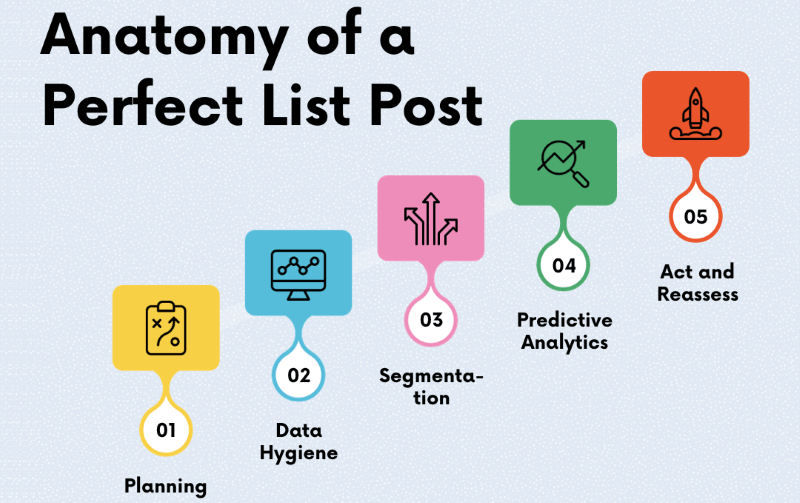Anatomy of a Perfect List Post

Are list posts part of your content marketing strategy?
If they’re not, they definitely should be! List posts are the second most-shared form of content, after infographics. They’re easy-to-digest for readers, and have an instant viral quality. That doesn’t mean you can sit down to pen the perfect list post without effort, though. There are tactics you can use to improve your content’s performance. Here is some of the latest data to improve your approach:
1. Use the Right Number of Items
10 items is better than 5. 7 items is better than 8. There’s some serious data science behind using the right number of items for list posts, and it’s to your advantage to know it and apply it.
Buzzsumo’s analysis of 100 million blogs found that lists of 10 items always perform best. 23, 16, and 24 also do pretty well. Use this knowledge to create the perfect list post.
2. Stay On-Topic
List posts that wander and ramble are confusing to readers, who will most likely abandon the content in favor of a better read. Your list items should fit within a narrow niche, and all work to enhance the same message.
In fact, Buzzfeed’s own advice for viral content writers recommends “thinking laterally” and “appeal to niches.” What does that mean? A blog on “27 Reasons You Know You’re a Content Marketer” will almost definitely outperform “15 Tips for Content Marketers,” because it’s simply a more cohesive concept.
3. Say No to Strange Formatting
If you’re aim is to the write the perfect list post, just say no to doing anything really avant-garde or experimental. The following tactics aren’t recommended:
- List items of significantly different lengths
- Extremely long list items
- Using multiple types of formatting throughout the article
- Using different types of list item titles
Your readers expect your content to be formatted consistently. Deliver what they expect!
4. Include an Introduction
Have you ever read a viral list post that lacked an introduction?
I bet you haven’t! Every perfect list post requires an introduction. Set the stage for your blog, and let the reader know what they’re in for. Articles without an introduction can seem amateurish or feel jarring to the reader.
5. Write Longer Posts
You can certainly write 600-word list posts, and they may perform well. However, to have the best shot at penning the perfect list post, your content should be slightly longer.
SERPIQ research has found that the best-performing content is always longer than 2,000 words, based on a major research study. Among these top-performers, longer was almost always better, with content around 2,400-2,500 words coming in first place. Your list posts must be long enough to provide some serious value!
6. Take a Numeric Approach to Your Title
It may come as a surprise to you, but one of the following blog titles will always outperform the other:
1. 10 Tips for Hiring the Perfect Copywriter
2. Ten Tips for Hiring the Perfect Copywriter
The first option will win every time. What, really?
Julie Neidlinger points out that this fact is related to the laziness of the human brain. As readers, we’re more likely to instantly recognize “10 Tips” as being a list post, and click on it.
7. Brainstorm Items
Readers know when they see “filler” content on a list post. This tactic is sure to leave a bad taste in their mouths, and ruin your chances of having your content shared on social media.
ProBlogger’s Darren Rowse recommends starting by brainstorming more items than you need for a list post. Eliminate the candidates that don’t fit your theme, are silly or common sense, or
won’t provide much value. By working backwards to compile a list of items for your outline, you’ll achieve the perfect list post.
8. Use Numbers

This may seem like common sense, but it isn’t always. If you fail to use numbers in your list post, your readers may struggle to wade through your content. Even worse, they could feel cheated by your content: “I was promised 10 tips, but all I got was this huge, rambling blog!”
Incorporating numbers is crucial to a successful list post. I don’t recommend trying otherwise, without exception.
9. Conclude with a Bang
Do you really need a conclusion on list posts? Yes, you do, and they need to resemble a conclusion. Neil Patel’s research indicates that reader engagement is 10% better with list posts that include a conclusion. In fact, many readers start with the conclusion, and then work backwards to read the list.
From introduction to conclusion, formatting, titles, and length, there are a lot of elements that go into creating the perfect list post. By using these data-driven content marketing tips to your advantage, you can leverage the natural viral quality of this type of content.
Are you an avid reader of list posts? What are your pet peeves when it comes to these types of blogs?

Comments (0)